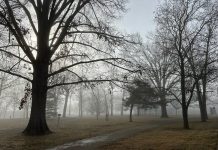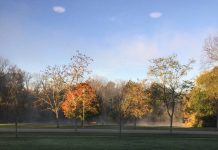Story by
Cecelia Ellis
It was the smell of pancakes in the Hauser Jr.-Sr. High School School hallway that first led Natalie Taylor down the path that affected all of her high school years and her foreseeable future.
“That day changed my entire life,” said Taylor, as she described the day in seventh grade when she first discovered the school’s FFA (historically called Future Farmers of America) program, in which she would participate throughout middle school and high school.
“I was just running an errand for a teacher when I smelled pancakes cooking. The pancakes smelled good and it all looked very interesting, but I thought FFA was just for kids who lived on a farm. I asked some of the kids I knew in the program what they were doing and they told me about it and convinced me I could join, too,” said Taylor, a 2017 Hauser graduate who is now an Indiana FFA officer, serving as the state reporter.
[sc:text-divider text-divider-title=”Story continues below gallery” ]
The Hope FFA chapter has more than 90 members, and about 1 in 4 Hauser Jr.-Sr. High School students belongs to FFA. Like Taylor, most of the students have no previous knowledge of agriculture.
“It’s not just about cows, plows and sows anymore,” said Grace Hasler, the current Hope FFA chapter president and Hauser senior.
Changes over time
Though the number of farms in Indiana has declined, according to state data, the number of members in Indiana’s FFA Chapters continues to soar. During the 2016-17 year, Indiana recorded 12,506 active FFA members, the most members ever recorded, according to state data.
The modern FFA is a student organization designed to promote personal leadership skills, character traits and career success paths among members to ensure a steady supply of young professionals capable of meeting today’s challenges in the science, business and technology of agriculture, Hasler said.
Originally founded and named the Future Farmers of America in 1928, the FFA was first designed to teach only male students haw to be good farmers. During the 1960s, the FFA was opened to female students and in 1988 the organization was officially renamed the National FFA.
Current national membership is 43 percent male, 32 percent female and 27 percent non-disclosed, Taylor said.
With more than 653,000 members, the National FFA is among the largest student organizations in the United States, according to the National FFA website.
Each state operates its own FFA administration under the National FFA. In each state, shapters operate in middle and high schools under the direction of certified agriculture education teachers The FFA operates in 8,568 chapters in middle and high schools in all 50 states and Puerto Rico and the Virgin Islands.
“Now kids come to us because they say they want to learn how to grow things or do landscaping and those kinds of things, but it is really about so much more than that. I’ve heard so many people say it’s like being in a family. It’s a family thing,” Jennings County High School FFA adviser Brad Briggs said.
Project-based learning
Briggs said a school’s agriculture-related classes and an FFA chapter go-hand-hand. Each FFA chapter must have an sponsor and the sponsor must have a degree in agricultural education. Each FFA student member must be enrolled in at least one agriculture subject class. It is recommended that each FFA member participate in a supervised project, he said.
Briggs also said some class subjects are considered agriculture-related because they teach how to do things that are helpful on a farm.
“Welding would be one example of that. Welding doesn’t directly help anything grow, but it is a necessary tool in many projects. We used welding in our project to make raised beds for Hayden and Sand Creek elementary schools. We’re making those beds so the elementary kids can learn how to grow carrots and the like,” Briggs said.
In addition to individual supervised projects, each chapter is expected to conduct group FFA projects.
“We used to farm produce tilapia, but now our project is making these raised beds so other people can grow things. Really, everything we do in some way is designed to teach people the tools they need to make sure everyone can be fed,” Briggs said.
The Columbus FFA chapter is a combination of students from East and North high school. Recently, its members assisted at local pig sales.
“We keep the pigs in the cages, clean up after them and just do things that keep the pig sale going smoothly. It’s work, but it’s fun, too,” said Columbus FFA chapter president Cassandra Claycamp.
The Columbus FFA chapter also is involved in several fundraising projects to aid the FFA Leadership Center in Trafalgar.
“They are trying to pay off the center and we are trying to help them do that,” Claycamp said.
The Columbus chapter is predominantly female and non-farm related, Claycamp said.
“We have many members who are not farm-related or a part of agriculture, but they come in and learn to have fun with it. That is one of my favorite things, people from different backgrounds all coming together, Claycamp said.
Family affair
Dena Hasler, mother of Hope FFA members and sisters Grace and Mel Hasler, was raised on a farm and attended Hauser High School, but she was not a member of FFA then.
“When I was at Hauser, the FFA was predominately boys. I didn’t realize what FFA is all about. Grace and Mel’s involvement in FFA has been life-changing,” Dena Hasler said.
Dena Hasler speaks highly of Hauser FFA adviser Aleesa Dickerson, and the FFA group projects in which her daughters Grace and Mel have participated.
“There is no better place than FFA to learn about giving back to your community. The Hope FFA chapter is always involved in a project — from the Developmental Preschool Day at the Farm, Monday Night Meal Site, Feed My Starving Children, Elementary Ag Day, Christmas Shopping for families in need and raising money to help a fellow FFA member who was injured in an accident, just to name a few. These kids learn the value of giving back and helping others. Not only are they given many opportunities to serve, they are allowed to lead and make a difference,” Dena Hasler said.
Mel Hasler, a Hauser sophomore, serves as the Hope FFA chapter secretary.
“I am proud of every project I have taken part in, but I have to say I have also learned something from every project,” she said, citing her supervised project as an example.
“My sister and I have (ridden) in rodeos since we were little kids. My Grandpa (Dick) Wetzel taught us about horses before we went to school. The FFA taught me a lot about public speaking and those kinds of things, and now I am more confident competing in rodeos,” Mel Hasler said.
“I am using parts of my rodeo experience in my supervised project. It all comes together in the end,” she added.
Many things have changed in FFA since Grace and Mel Hasler’s father Michael served as president of the L&M High School chapter in the 1980s. It was still predominately a male organization then.
“There is more focus on ag-related industries and less focus on farming itself,” Michael Hasler said.
There are now more than 200 approved FFA activities in Indiana’s chapters. Activities include learning trades, public speaking, agricultural communications and leadership courses. There are competitions at chapter, district, state and national levels, including topics such as ag sales, job interviews, public speaking and leadership skill training.
There are conferences held within each of the states and at national levels. The National FFA conventions will be conducted in Indianapolis each year until 2024.
Grace Hasler, who will graduate this spring and then study agriculture at Purdue University, said she was excited to join FFA because of the opportunities.
“When I joined FFA, I learned I could do things. I learned I could do a lot of things. FFA has influenced everything I do today and what I plan to do in the future,” she said. “Agriculture made this country what it is today. The way agriculture is done is changing, but the importance to our world has not changed. I want to be a part of keeping agriculture strong for our country.”
BARTHOLOMEW COUNTY
Columbus
(East and North high schools combined)
- Adviser: Allison Korb
- Location: East High School
Hope
- Adviser: Aleesa Dickerson
- Location: Hauser Jr.-Sr. High School
JENNINGS COUNTY
- Adviser: Brad Briggs
- Location: Jennings County High School, North Vernon
JACKSON COUNTY
Seymour High School
- Adviser: Jeanna Eppley
Seymour Middle School
- Adviser: Micah Wallace
Trinity Lutheran High School
- Adviser: Bryan Schroer
Crothersville High School
- Adviser: Mrs. Linda Myers
Medora High School
- Adviser: Ashley Kincaid




